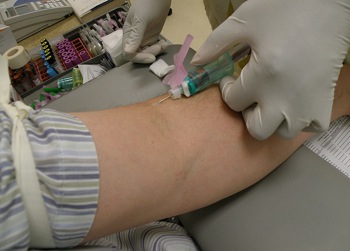
Procedures and Surgeries
Introduction

venipuncture - Richard Chambers
Procedures and surgeries are important and common components of diagnosis and treatment for primary care providers. They range from simple and minimally risky to complex and potentially life-threatening. All procedures are a series of motor skills, with significant cognitive and affective requirements as well. As such, the training required to become competent in procedures and surgeries can be very involved.
Over 2 billion people worldwide are estimated to have insufficient access to surgery (Funk et al, 2010).
Procedural and Surgical Care For Primary Care Providers
Surgeons are physicians involved in anatomic correction. General surgeons perform a wide variety of procedures, focusing on the chest and abdomen. Other surgical specialties include obstetrics and gynecology, orthopedics, ear/nose/throat, urology, neurosurgery, plastic surgery, cardiovascular, and many others. However, a vast array of procedures and surgeries may be performed by primary care providers. These core topics are discussed here.
- foundations
- common
procedures - essential surgeries
and recuscitation - pre-op and
post-op care
Foundations
surgical techniques
|
analgesia/anesthesia
|
wounds
|
Common Procedures
Skin
|
EENT
|
Gastrointestinal
|
|
Genitourinary/women's health |
Musculoskeletal
|
Injections and Lines
|
|
Essential Surgeries and Recuscitation
Essential Surgeries
|
Recuscitation |
Pre-Operative Care
|
preparation for surgery
|
communication/documentation
post-operative care
|
common complications
|
Resources and References
Online ResourcesWHO - Essential and Emergency Surgical Care
Primary-surgery.org - non-Trauma, trauma and anaesthesia manuals for physicians with basic surgical knowledge to cope with all surgical symptoms.
Global HELP - free PDF books, especially in regards to pediatric surgery
Ptolemy.ca - University of Toronto Office of International Surgery electronic resources
$ Procedures Consult - paid-access videos by Elsevier |
OrganizationsUniversity of Toronto Surgical Skills Centre
Canadian Network for International Surgery
Global Partners in Anaesthesia and Surgery
CompetenciesAFMC undergraduate medical students competencies
Wetmore S et al. 2005. Core Procedure Skills for Canadian Family Medicine Training. CFP.
|
References
Funk LM. 2010. Global operating theatre distribution and pulse oximetry supply: an estimation from reported data. Lancet. 376(9746):1055 - 1061.
http://2ndassist.com/what_our_work.htm
http://ices3.wpengine.com/
